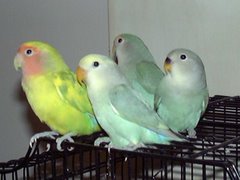Tips for successful lovebirds breeding
A healthy lovebird is a good breeder in near future.
Hence it is mandatory to improve the health of your lovebirds in your cage.
Here the few steps that will help you to maximize the breeding potentiality of
your lovebirds.
Age
of breeding
As a lovebird’s
breeder, you should know the age of your lovebird. The lovebird between 1 and 5
years old is suitable for breeding. The sex ratio should be 1 male for 5
females.
Nest
boxes
Nest box plays an important role in breeding lovebirds. Nest
box should be of 12 inches x 12 inches x 12 inches. The entrance hole in the
nest box should be of 3 inches diameter.
Nutritional
care
During breeding season, you should feed the lovebirds
with fresh fruits, vegetables, and greens (Coriander leaves). Supplementation with calcium is essential for
the hens that are going to lay eggs.
Sexing
of lovebirds
Do you know lovebirds are sexually monomorphic? It is very difficult
to differentiate male and female as the species look alike. DNA sexing is the
only way to ascertain the sex of the bird.
Laying of eggs
Female lovebirds will lay
at least 3 to 7 eggs on alternate days.
In general, they will lay eggs after 5-7 days of mating.
Period of Incubation
Lovebirds will incubate
the eggs for 23 days. You should calculate the days of incubation start from
the day on which the hen sits on the egg continuously
Hatchling care
Both sexes will take part in hatchling rising by feeding
the chicks daily. Extra feed such as green food and soaked seeds (millets) are
of best choice. In general chicks will come out of the nest box at the age of
six weeks. No chicks will remain in the nest box after eight weeks of age. The
young ones will make use of nest box for night stay for two more weeks. You
should keep in mind that once the young one learned to feed independently, it
should be move on to another cage, otherwise the male will try to kill the
offspring.








 Free Ads For Bloggers
Free Ads For Bloggers


No comments:
Post a Comment